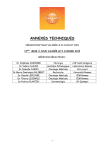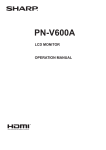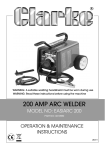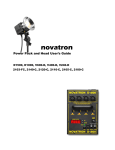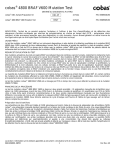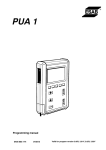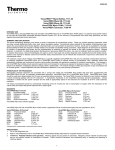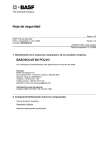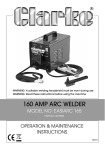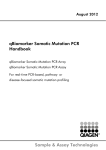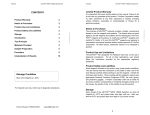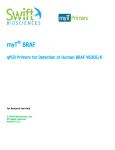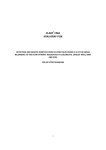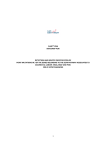Download Package Inserts
Transcript
410697 16464 C - en - 2013/09 THxID™-BRAF The THxID™-BRAF kit is an In Vitro Diagnostic device intended for the qualitative detection of the BRAF V600E and V600K mutations in DNA samples extracted from formalin-fixed paraffin-embedded (FFPE) human melanoma tissue. The THxID™-BRAF kit is a real-time PCR test on the ABI 7500 Fast Dx system and is intended to be used as an aid in selecting melanoma patients whose tumors carry the BRAF V600E mutation for treatment with dabrafenib [Tafinlar®] and as an aid in selecting melanoma patients whose tumors carry the BRAF V600E or V600K mutation for treatment with trametinib [Mekinist™]. bioMérieux SA English - 1 THxID™-BRAF 16464 C - en - 2013/09 SUMMARY AND EXPLANATION The RAS/RAF/MEK/ERK pathway is a critical proliferation pathway in many human cancers. This pathway can be constitutively activated by alterations in specific proteins, including BRAF, which phosphorylates MEK on 2 regulatory serine residues. Over 45 cancer-associated mutations have been identified in BRAF (1). BRAF mutations have been identified at a high frequency in specific cancers, including approximately 50 to 60% of melanoma (2), Approximately 90% of all identified BRAF mutations that occur in human cancer are a T1799A transversion mutation in exon 15, which results in a V600E amino acid substitution (3). This mutation appears to mimic regulatory phosphorylation, locks the BRAF kinase in its active status, and increases BRAF activity approximately 10-fold compared to wild type (2). T1799A alteration (V600E mutation) accounts for 70 to 90% of BRAF mutant melanoma patients. In addition, the T1799A alteration could be associated with a second nucleotide mutation (G1798A) and leads to a V600K mutation in an additional ~6% to 29% of patients with a BRAF mutation (4). Dabrafenib is a selective inhibitor of BRAF kinase activity and trametinib is a selective inhibitor of MEK activity for tumors that carry T1799A and/or GT1798-1799AA alterations in the BRAF gene. The clinical utility of this kit is to evaluate the BRAF (V600E / K) (T1799A / GT1798-1799AA) mutation status in order to screen patients for treatment with the dabrafenib or trametinib. bioMérieux SA PRINCIPLE The THxID™-BRAF kit allows detection of the V600E and V600K mutations of the BRAF gene from FFPE sections. For this, the THxID™-BRAF kit makes use of 2 major processes: • Nucleic acid isolation from FFPE sections through extraction / purification steps: The paraffin is removed. The sample is lysed then heated to reverse formalin crosslinking. The DNA is bound to a membrane. After washing, concentrated DNA is eluted from the membrane. • Real time PCR amplification and detection of target DNA (BRAF gene) present in the total nucleic acids: Amplification Refractory Mutation Specific System (ARMS) (5) PCR technology is used. In the PCR reaction, primers specific for the BRAF gene allow the amplification of a non-polymorphic gene area, which is used as an internal control. The primers specific for the mutations V600E and V600K allow the amplification of mutated fragments leading to the identification of BRAF mutations. Target specific probes bind instantaneously to the newly synthesized complementary DNA. In the THxID™-BRAF kit, 2 different probes labeled with 2 different dyes allow the simultaneous detection of the BRAF internal control and a BRAF mutation. Kinetic analysis of the fluorescent signals and delta Ct (Crossing threshold) calculation reveal the presence of potential BRAF mutations. English - 2 THxID™-BRAF 16464 C - en - 2013/09 CONTENT OF THE KIT (48 tests) THxID™-BRAF PUR Contents Components THxID™-BRAF Columns with Wash Tubes (50) COL Columns in tubes THxID™-BRAF Wash Tubes 3 x 50 (2 mL) WT 2 mL tubes THxID™-BRAF Elution Tubes 1 x 50 (1.5 mL) ET 1.5 mL tubes THxID™-BRAF Lysis Tubes 1 x 50 (2 mL) LT 2 mL tubes THxID™-BRAF Tissue Lysis Buffer (10 mL) Composition ATL Edetic acid Sodium dodecyl sulphate AL Guanidine salt (GuHCl)* 25-50% THxID™-BRAF Wash Buffer 1 (concentrate) (19 mL) AW1 Guanidine salt (GuHCl)* 50 – 100% THxID™-BRAF Wash Buffer 2 (concentrate) (13 mL) AW2 Sodium azide (NaN3) < 1% THxID™-BRAF Elution Buffer (14 mL) ATE Sodium azide (NaN3) < 1% THxID™-BRAF Proteinase K (1.25 mL) PK THxID™-BRAF Lysis Buffer (12 mL) Proteinase K** * HARMFUL reagent: - R22: Harmful if swallowed. - R36/38: Irritating to eyes and skin. - S13: Keep away from food, drink and animal feeding stuffs. - S26: In case of contact with eyes, rinse immediately with plenty of water and seek medical advice. - S36: Wear suitable protective clothing - S46: If swallowed, seek medical advice immediately and show this container or label. ** HARMFUL reagent: - R36/37/38: Irritating to eyes, respiratory system and skin. - R42: May cause sensitization by inhalation. - S22: Do not breathe dust. - S24: Avoid contact with skin - S26: In case of contact with eyes, rinse immediately with plenty of water and seek medical advice. - S36/37: Wear suitable protective clothing and gloves. For further information, refer to the Material Safety Data Sheet available on request. bioMérieux SA English - 3 THxID™-BRAF 16464 C - en - 2013/09 THxID™-BRAF AMP Contents Components Cap colors Composition V600E Primers and Probes 6 x 5.2 mg (lyophilized) PRM V600E Blue Sphere containing: • synthetic primers, • synthetic fluorescent-labeled probes. Each tube packed in a foil pack with silica gel desiccant. V600K Primers and Probes 6 x 5.2 mg (lyophilized) PRM V600K Lilac Sphere containing: • synthetic primers, • synthetic fluorescent-labeled probes. Each tube packed in a foil pack with silica gel desiccant. MM Red Mix containing: • Tris Buffer, • PCR enzyme, • UNG amperase, • Glycerol, • Nucleotides, • Sodium Azide (NaN3), • Passive reference dye. Master Mix* 6 x 0.24 mL (liquid) Primers Diluent 6 x 0.5 mL (liquid) PRMdil Blue Diluent containing: • RNase/DNase-free water, • preservative. < 1% Positive Control Diluent 6 x 0.5 mL (liquid) CONT+dil Yellow Diluent containing: • RNase/DNase-free water, • preservative. Positive Control 6 x 6.4 mg (lyophilized) CONT+ Yellow Sphere containing: synthetic DNA. Each tube packed in a foil pack with silica gel desiccant. *: contains products of animal origin MATERIAL REQUIRED BUT NOT PROVIDED For information, please contact the local bioMérieux representative. General • Calibrated micropipettes with variable settings for 1 to 1000 µL delivery volumes • Timer • Vortex-type mixer • Sterile, disposable, aerosol resistant tips • Waste container with cap or sealable • Powder free gloves Sample preparation • DNase and RNase-free microtubes • Scalpel • Xylene 99% • Ethanol (96 – 100%) molecular biology grade • 37°C, 56°C and 90°C dry bath for incubation of 1.5 mL or 2 mL microtubes • Microcentrifuge 20000 g for 2 mL microtubes Amplification with Applied Biosystems 7500 Fast Dx Real-Time PCR instrument • 7500 Fast Dx Instrument including Sequence Detection Software v1.4 Security, Auditing, and E-Signature module (Ref. Applied Biosystems 4406984 or 4406985). bioMérieux SA For 8-tube strips • Mini-Strip Centrifuge (Ref. bioMérieux 285056 or equivalent) • MicroAmp Fast 8-Tube Strip, 0.1 mL (Ref. Applied Biosystems 4358293) • MicroAmp Optical 8-Cap Strip (Ref. Applied Biosystems 4323032) • MicroAmp Cap Installing Tool (Handle) (Ref. Applied Biosystems 4330015) • Precision Plate Holder for 0.1 mL tube strips for 7500 Fast System (Ref. Applied Biosystems 4388506) For 96-well plates • Centrifuge for 96-well plates • MicroAmp 96- and 384-well Optical Adhesive Film (Ref. Applied Biosystems 4311971) • MicroAmp Fast Optical 96-Well Reaction Plate with Barcode 0.1 mL (Ref. Applied Biosystems 4346906) • MicroAmp Adhesive Film Applicator (Ref. Applied Biosystems 4333183) Interpretation of results with the THxID™-BRAF software • Workstation with THxID™-BRAF software • THxID™-BRAF templates • Printer (optional) English - 4 THxID™-BRAF 16464 C - en - 2013/09 WARNINGS AND PRECAUTIONS • For In Vitro Diagnostic use only. • For professional use only. • This kit contains products of animal origin. Certified knowledge of the origin and/or sanitary state of the animals does not totally guarantee the absence of transmissible pathogenic agents. It is therefore recommended that these products be treated as potentially infectious and handled observing the usual safety precautions (do not ingest or inhale). • When working with chemicals (for example Xylene), consult the appropriate Material Safety Data Sheet available from the product supplier. • The Buffer AL and Buffer AW1 contain a harmful and irritant agent (guanidine hydrochloride). Refer to the risk phrases “R” and the precautions “S” above. Guanidine hydrochloride can form highly reactive compounds when combined with bleach. If liquids containing these buffers are spilt, clean with liquid detergent and water. If the spilt liquid contains potentially infectious agents, clean the affected area first with liquid detergent and water, and then with 1% sodium hypochlorite. • The Proteinase K reagent is a harmful agent. Refer to the risk phrases “R” and the precautions “S” above. • Kit reagents contain sodium azide which can react with lead or copper plumbing to form explosive metal azides. If any liquid containing sodium azide is disposed of in the plumbing system, drains should be flushed with water to avoid build-up. • Do not use reagents or Columns after the expiration date indicated on the label. • Do not mix reagents (or disposables) from different lots. • Check that the reagents are intact before use. • Make sure reagents and samples are at 18-25°C before use. • All centrifugation steps should be carried out at 18-25°C. • Make sure that the lyophilized material is at the bottom of the tube before opening the tube. • Ensure sample-to-result traceability by appropriate labeling of the container at each transfer step (e.g. lysate transfer, etc.) and at the level of the strips in the PCR instrument. • Avoid contamination or sample-to-sample carry-over: - Never open more than one tube at a time to minimize the risk of cross-contamination. - Perform FFPE extraction and amplification in separate dedicated laboratory areas (preferably a self-contained area or laminar flow hood) using dedicated material. - Use a fresh aerosol-resistant pipette tip (or equivalent) for each pipetting action. - Wear disposable gloves when working with amplified material. Change gloves after contact with nucleic acids. Wash hands thoroughly after completion of the test procedure. - Resuspend the V600E and V600K spheres before the control sphere. - To avoid amplicon contamination and to reduce the risk of evaporation ensure amplification strips remain closed. • Use powder free gloves as powder may inhibit the PCR reaction and cause invalid results. bioMérieux SA • Handling of Columns: - Carefully apply the sample or solution to the Column. Pipet the sample into the Column without wetting the rim. - Avoid touching the Column membrane with the pipet tip. - After all pulse-vortexing steps, briefly centrifuge the microcentrifuge tubes to remove drops from the inside of the lids. - Open only one Column at a time and avoid generating aerosols. • Collect used disposable materials in a sealable container. Close and remove the container after each test run. • Soak tube racks in a suitable detergent after each test run for at least one hour. • All materials and instruments should be regularly cleaned and decontaminated. Immediately clean up any spillage containing tissue lysate with liquid detergent or a solution of household bleach containing at least 1% sodium hypochlorite. For cleaning spills on or in the 7500 Fast Dx Real-Time PCR instrument, refer to the User’s Manual. LIMITATIONS OF THE METHOD • THxID™-BRAF kit is to be used by professionals trained and skilled in molecular biology techniques. • The product must be used in strict accordance with the instructions for use. Any deviation from the procedure should be validated by the end-user. • Melanin is a known inhibitor of PCR reactions. Melanin may interfere with the THxID™-BRAF assay in highly pigmented samples. If melanin inhibition is suspected, repeat testing using a 1:4 dilution as suggested in the troubleshooting table. 2 • The claimed tumor area for the assay is 20 mm to 2 250 mm (for a 10 µm section). Smaller tissue 2 (i.e., < 20 mm ) areas cannot ensure reliable results. • The assay has been validated for a DNA input range of 10-350 ng/µL • Users should ensure thermocycler temperature is correctly calibrated as incorrect temperatures can lead to invalid results. • The test is designed to detect the BRAF V600E and V600K mutations. Samples with results reported as BRAF mutation negative may harbor BRAF mutations not detected by the assay (e.g., V600R). • Results that suggest E/K heterogeneity of the sample may potentially come from a homozygous sample (see accuracy section). • The V600E PCR in the THxID™-BRAF assay crossreacts with the V600D. The assay has not been validated to reliably detect V600D. Refer to the section on performance studies below. • The presence of AL Buffer in the eluate (tested by adding 5 µL AL Buffer in the eluate) may lead to a false result for a mutant sample which may then be reported as “BRAF mutation negative”. • The THxID™-BRAF kit is validated for FFPE skin and lymph node melanoma tissue. • The THxID™-BRAF kit is only validated for use with the THxID™-BRAF PUR kit and the ABI 7500 Fast Dx Real Time PCR instrument. • The THxID™-BRAF kit is not to be used for diagnosis. English - 5 THxID™-BRAF 16464 C - en - 2013/09 STORAGE CONDITIONS THxID™-BRAF PUR Stability Kit stability THxID™-BRAF PUR kit: until the labeled expiration date at 2-8°C or 18-25°C. The Columns must be stored at 2-8°C. Reconstituted Buffer AW1 6 months at 18-25°C or until the expiration date of the kit. Reconstituted Buffer AW2 6 months at 18-25°C or until the expiration date of the kit. THxID™-BRAF AMP Stability Kit stability THxID™-BRAF AMP kit: until the labeled expiration date at 2-8°C. PRM V600E solution • 30 minutes at 18-25°C • 1 month at -19°C to -31°C Re-use frozen solution a maximum of 2 times. After each thawing, mix and spin down briefly before use. PRM V600K solution • 30 minutes at 18-25°C • 1 month at -19°C to -31°C Re-use frozen solution a maximum of 2 times. After each thawing, mix and spin down briefly before use. Master Mix 30 minutes at 18-25°C Re-use solution a maximum of 2 times. Reagent Mix solution (primer / probe solution + Master Mix) 30 minutes at 18-25°C CONT+ solution • 30 minutes at 18-25°C • 1 month at -19°C to -31°C Re-use frozen solution a maximum of 2 times. After each thawing, mix and spin down briefly before use. Samples Stability 5 and 10 µm thick FFPE section in tube or mounted on slides • 3 months at 18-25°C • 3 months at 2-8°C • 3 months at -19°C to -31°C FFPE specimens can be transported at 18-25°C. Eluate • 2 hours at 18-25°C • 48 hours at 2-8°C • 7 months at -19°C to -31°C • 7 months at ≤ - 60°C Re-use frozen solution a maximum of 4 times. After each thawing, mix and spin down briefly before use. bioMérieux SA English - 6 THxID™-BRAF 16464 C - en - 2013/09 INSTRUCTIONS FOR USE Sample requirements • Standard formalin-fixation and paraffin-embedding procedures should be followed. To limit the extent of DNA fragmentation: - Fix tissue samples in 10% formalin as quickly as possible after surgical removal. - Use a fixation time of 14–24 hours (longer fixation times lead to more severe DNA fragmentation, resulting in poor performance in THxID™-BRAF assay). - Thoroughly dehydrate samples prior to embedding (residual formalin can inhibit the Proteinase K digestion). • Sections will be processed according to the pathologist’s indications: 1. If the sample section contains more than 80% of tumor cells and does not contain a distinct area of necrotic tissue, fatty tissue, hemorrhagic tissue or non-tumoral melanin-rich area, then the entire section can be placed in a tube, or if the sample is on a slide, it can be entirely scraped with a scalpel. 2. If the sample section contains less than 80% of tumor cells, then the section must be manually macro-dissected in order to reach a final content of at least 80% tumor cells. Use a dedicated sterile scalpel to select the tissue part in order to enrich the sample in tumoral cells. 3. If the sample section contains necrotic tissue, fatty tissue, hemorrhagic tissue or non-tumoral melaninrich area, then the section should be manually macro-dissected. Use a dedicated sterile scalpel to select the tissue part in order to avoid the undesirable portion. • The minimum surface of tissue required for a 10 µm 2 section is 20 mm , not counting the necrotic / fatty / hemorrhagic / non-tumoral melanin-rich area if it is deemed dissectible (see above). If 5 µm sections are 2 prepared, the minimum is then 40 mm . Therefore a sufficient number of sections should be included to meet this requirement, while not exceeding 8 x 10 µm sections (or 16 x 5 µm sections) to stay within the recommended limit of the purification column. 2 • The total surface of tissue should not exceed 250 mm if 2 10 µm sections are prepared or 500 mm if 5 µm sections are prepared. Note: Use a single scalpel per sample. Preparation of purification reagents • Equilibrate all buffers at 18-25°C. • Before starting the procedure, check whether precipitate has formed in Buffer AL or Buffer ATL. If necessary, dissolve by heating to 70°C with gentle agitation. Preparing Buffer AW1 Add 25 ml ethanol (96-100%) to the bottle containing 19 ml Buffer AW1 concentrate. Write down the current date on the label after ethanol addition. Note: Before starting the procedure, mix reconstituted Buffer AW1 by shaking. bioMérieux SA Preparing Buffer AW2 Add 30 ml ethanol (96-100%) to the bottle containing 13 ml Buffer AW2 concentrate. Write down the current date on the label after ethanol addition. Note: Before starting the procedure, mix reconstituted Buffer AW2 by shaking. Sample preparation • Immediately place the dissected sections in a Lysis Tube (1.5 mL microtube (not provided) or 2 mL Lysis Tube (LT)). Note: electrostatic effect can be observed for dissected sample. Transfer the whole dissected area inside the tube and briefly centrifuge. • Prepare an empty Lysis Tube for the Negative Control which will undergo the whole process. • Add 1 mL xylene to all microtubes (samples and Negative Control). • Close the tube and mix at full speed using a vortex-type mixer for at least 10 seconds. • Centrifuge at full speed (approximately 20000 g) for 2 minutes ± 30 seconds at 18-25°C. • Remove the supernatant by pipetting. Make sure to leave 50-100 µL of supernatant in order not to remove any of the pellet. • Add 1 mL ethanol (96-100%) to the pellet, and mix briefly at full speed using a vortex-type mixer. • Centrifuge at full speed (approximately 20000 g) for 2 minutes ± 30 seconds at 18-25°C. • Remove the supernatant by pipetting. Do not remove any of the pellet. Carefully remove any residual ethanol using a fine pipet tip. • Open the tube and dry at 37 ± 2°C for 10 ± 1 minutes or until all residual ethanol has evaporated. • Add 180 μL Buffer ATL to the dry pellet. • Add 20 μL proteinase K. • Mix briefly at full speed using a vortex-type mixer. • Incubate at 56 ± 3°C for 1 hour ± 5 minutes. • Incubate at 90 ± 5°C for 1 hour ± 5 minutes. If using only one heating block, leave the sample at 18-25°C after the 56°C incubation until the heating block has reached 90°C. • Briefly centrifuge the Lysis Tube to remove drops from inside the lid. • Add 200 μL Buffer AL to the sample, and mix at full speed using a vortex-type mixer. • Add 200 μL ethanol (96-100%) and mix again at full speed using a vortex-type mixer. A white precipitate may form upon addition of Buffer AL and ethanol. This precipitate does not interfere with the extraction procedure. • Briefly centrifuge the Lysis Tube to remove drops from inside the lid. • Carefully transfer the entire lysate (with the white precipitate if any) to the Column (in a 2 mL Wash Tube) without wetting the rim. • Close the lid. • Centrifuge at approximately 6000 g for 1 minute at 18-25°C. If the lysate has not completely passed through the membrane after centrifugation, centrifuge again at a higher speed until the Column is empty. • Place the Column in a clean 2 mL Wash Tube (WT). • Discard the Wash Tube containing the flow-through. • Carefully open the Column and add 500 μL of Buffer AW1 without wetting the rim. English - 7 THxID™-BRAF 16464 C - en - 2013/09 • Close the lid. • Centrifuge at approximately 6000 g for 1 minute at 18-25°C. • Place the Column in a clean 2 mL Wash Tube. • Discard the Wash Tube containing the flow-through. • Carefully open the Column and add 500 μL of Buffer AW2 without wetting the rim. • Close the lid. • Centrifuge at approximately 6000 g for 1 minute at 18-25°C. • Place the Column in a clean 2 mL Wash Tube. • Discard the Wash Tube containing the flow-through. • Centrifuge at full speed (approximately 20000 g) for 3 minutes at 18-25°C to dry the membrane completely. Note: Avoid contact between the Column and the flowthrough. Take care when removing the Column and Wash Tube from the rotor so that flow-through does not come into contact with the Column. • Place the Column in a clean 1.5 mL Elution Tube (ET). • Discard the Wash Tube containing the flow-through. • Carefully open the lid of the Column and apply 60 μL of Buffer ATE to the center of the membrane. • Close the lid. • Incubate at 18-25°C for at least 1 minute. • Centrifuge at full speed (approximately 20000 g) for 1 minute at 18-25°C. Note: The volume of eluate will be up to 5 μL less than the volume of elution solution applied to the Column. • Transfer the tubes with nucleic acid extracts to the amplification laboratory area or store (see “Storage Conditions”). Amplification Switch on the 7500 Fast Dx Real-Time PCR instrument. Preparation of the SDS run file on the SDS software Refer to the section "Perform a run on the 7500 Fast Dx Real-Time PCR instrument". • Create a new run selecting the appropriate template. • Adapt the created run to the plate layout. Preparation of PCR reagents Equilibrate reagents and samples at 18-25°C before use. Preparation of primer and probe solution • Add 85 µL of PRM diluent to the V600E and V600K primer sphere. When more than 8 reactions are required, spheres with the same lot number must be pooled in one tube and diluent volume must be adapted. Maximum number of samples and controls to be run Number of spheres Volume of primer diluent (µL) 8 1 85 16 2 170 24 3 255 48 6 510 • Immediately mix at full speed using a vortex-type mixer until a clear solution has been obtained. • Centrifuge briefly. bioMérieux SA Notes: • With one sphere it is possible to do 3 runs of one sample (including the 2 controls). • As long as the remaining volume of V600E and V600K solutions is sufficient for 3 reactions, it can be stored (see “Storage Conditions”). • Do not pool the remaining volume of primer and probe solutions from different tubes. Preparation of reagent mix • Briefly centrifuge the Master Mix. • Mix the V600E or V600K solution with Master Mix according to the following table: Number of samples and controls to be run V600E or V600K solution (µL) Master Mix (µL) 3 27 36 8 85 110 16 170 220 24 255 330 48 510 660 If another number of samples is to be run, make sure to use 8 µL of V600E or V600K solution per reaction and to leave a certain margin to calculate the volumes needed. It is important to maintain a volume of Master Mix that is 1.3 times higher than the volume of primer solution (rounding up to the nearest whole number). • Mix at full speed briefly using a vortex-type mixer. • Centrifuge briefly. Warning: The remaining volume of reagent mix cannot be stored and should be used within 30 minutes. Preparation of Positive Control solution • Add 150 µL of Positive Control Diluent to the Positive Control sphere. • Mix at full speed using a vortex-type mixer until a clear solution has been obtained. • Centrifuge briefly. Notes: The remaining volume of Positive Control can be stored (see “Storage conditions”). Do not pool the remaining volumes of Positive Control solutions from different tubes. Repartition of reagents in 8-tube strips or 96-well plates Per single sample, the DNA amplification is carried out in 2 wells each containing a duplex PCR reaction. The V600E duplex PCR contains the internal control PCR and the V600E mutation-specific PCR. The V600K duplex PCR contains the internal control PCR and the V600K mutation-specific PCR. A Negative Control (starting from the extraction process) and a Positive Control for amplification will be tested per run for each duplex reaction. For dispensing of the reagent mix and eluate, respect the plate layout from the created run. Note: Do not invert the V600E and V600K reagent mixes. English - 8 THxID™-BRAF 16464 C - en - 2013/09 In each tube of an 8-tube strip or of a 96-well plate: • Following the plate layout, transfer 18 µL of the V600E or V600K reagent mix to the bottom of a single tube. • Add 2 µL of Positive Control or Negative Control or sample eluate to the dedicated tube. Mix by aspiration and dispensing. Note: After adding the reagent mix and controls or sample eluate(s) to all tubes, visually check that the volume in each tube is identical. Generate an SDS result file • At the end of the run, start the analysis on the instrument using "Auto Ct". Note: Do not modify any other items. The THxID™-BRAF software checks the instrument configuration. If configuration is incorrect, the software will not be able to interpret. • At the end of the analysis, save the SDS result file generated. Run amplification on the 7500 Fast Dx Real-Time PCR instrument Generate a BRAF mutation test report • Transfer a copy of the SDS result file to the dedicated THxID™-BRAF computer using for instance a USB stick and the menu "File\Save As" of the SDS software. Warning: If modifications need to be made to the SDS result file after it has been copied, do the following steps: - Update the SDS run file on the SDS software. - Destroy all existing copies of the previous versions of the SDS result file (recommended). - Destroy all the BRAF mutation test reports corresponding to the previous version of the SDS result file (recommended). - Resume the instructions for the modified SDS result file from the section “Generate an SDS result file”. • Generate a BRAF mutation test report for the SDS result file using the THxID™-BRAF software. For 8-tube strips • Close the strips using the MicroAmp Cap Installing Tool (Handle). • Properly identify the strips on the extremity of the cap strip according to the position in the plate layout. Note: Do not write directly on the caps or tubes as ink interferes with fluorescence readings. • Briefly centrifuge the strips. • Place the strips on the Precision Plate Holder according to the plate layout. Notes : - A minimum of 2 tube strips and a maximum of 6 tube strips can be run on the Precision Plate Holder at the same time. - Do not invert the V600E and V600K strips. • Insert 2 fully capped empty MicroAmp Fast 8-Tube st Strips in the 1 left and last columns of the Precision Plate Holder. • Start amplification on the instrument. For 96-well plates • Cover the 96-well plates with the adhesive film using the Adhesive Film Applicator. Note: Do not write directly on the plate as ink interferes with fluorescence readings; if necessary, use the sides of the plate. • Centrifuge the 96-well plates at 200 g for 3 minutes at 18-25°C. • Transfer the plates to the Applied Biosystems 7500 Fast Dx Real-Time PCR instrument. • Start amplification on the instrument. For complete instructions, refer to the 7500 Fast Dx RealTime PCR instrument User's Manual or / and to the THxID™-BRAF software User's Manual. RESULTS AND INTERPRETATION The THxID™-BRAF software interprets the results automatically and highlights the presence of valid or invalid results in the generated report. The 2 possible outcomes for Positive and Negative Controls are "valid" or "invalid". The result validity of clinical specimens is determined first by the internal control Ct (Crossing threshold) values that should fall within pre-specified limits. A result is invalid if one of the delta Ct or internal control Ct values falls outside the expected limits. If a specific amplification is detected for the mutant target, the result of each reaction (V600E or V600K) is based on the delta Ct value (Ct mutant – Ct IC): • If the delta Ct value is below a threshold value then a V600E or V600K BRAF mutation is present, • If the delta Ct value is above a threshold value then no V600E or V600K BRAF mutation is present or it is below the limit of detection. If no amplification is detected for the mutant targets (V600E and V600K not detected), the sample will be characterized as BRAF mutation-negative. The final result is determined based on results obtained for both multiplexes. bioMérieux SA English - 9 THxID™-BRAF 16464 C - en - 2013/09 Valid results of clinical specimens Reported result Description BRAF mutation negative V600E and V600K mutations not detected V600E mutation V600E mutation detected V600K mutation V600K mutation detected V600E and V600K mutations V600E and V600K mutations detected Invalid results Invalid control An invalid Positive or Negative Control invalidates the complete run. If one or more controls is invalid, the results of the clinical specimen obtained in the run are not reported. If an invalid result is obtained for a control, refer to the troubleshooting table below: Sample type Negative Control Message Description Amplification detected in Negative Control well for IC Contamination with internal control DNA was detected in the Negative Control well. Amplification detected in Negative Control well for V600E Contamination with V600E mutation DNA was detected in the Negative Control well. Amplification detected in Negative Control well for V600K Contamination with V600K mutation DNA was detected in the Negative Control well. Appropriate corrective measure The complete run must be repeated using frozen sample eluates, frozen Negative Control eluate and either frozen Positive Control if available or a new preparation. If the Negative Control is still invalid repeat the complete procedure starting from the extraction. Amplification for IC out of bounds in Positive Control well Positive Control Amplification for V600E out of bounds in Positive Control well Amplification for V600K out of bounds in Positive Control well This indicates that an error occurred during the process or that reagents failure was detected. Delta Ct out of bounds in Positive Control well bioMérieux SA English - 10 The complete run must be repeated using frozen sample eluates, frozen Negative Control eluate and a new preparation of Positive Control. THxID™-BRAF 16464 C - en - 2013/09 Invalid clinical specimen If an invalid result is observed for a clinical specimen in a valid run, refer to the troubleshooting table below. Sample type Message Description Appropriate corrective measure Too much DNA in the reaction, possible PCR overloading. The eluate has to be diluted 1:4 in Buffer ATE before amplification by adding 10 µL of eluate to 30 µL of Buffer ATE. If the result is still invalid, repeat the test starting from the extraction using lower tissue area. Sample IC amplification above maximum threshold in well XX. Too low DNA in the reaction and/or PCR inhibition. If the tested sample has been characterized as containing no or a low level of melanin (≤ 10%) by the pathologist, repeat the test, starting from the eluate. If the result is still invalid, repeat the test for the invalid sample, starting from the extraction using higher tissue area. If the tested sample has been characterized as containing a medium to high level of melanin (> 10%) by the pathologist, the eluate has to be diluted 1:4 in Buffer ATE before amplification by adding 10 µL of eluate to 30 µL of Buffer ATE. If the result is still invalid, repeat the test starting from the extraction using higher tissue area. Sample delta Ct too low in well XX. An unexpected ratio between IC and mutant PCR is detected. Repeat the test starting from the eluate. No available result due to control failure. No result is reported for this sample due to an invalid Positive and/or Negative Control. Please refer to the table for invalid control troubleshooting. Sample IC amplification below minimum threshold in well XX. Clinical specimen PERFORM A RUN ON THE 7500 Fast Dx Real-Time PCR INSTRUMENT (Refer to the 7500 Fast Dx Real-Time PCR instrument User's Manual). Templates for the 7500 Fast Dx Real-Time PCR instrument bioMérieux provides 4 templates for the 7500 Fast Dx Real-Time PCR instrument and its associated Sequence Detection Systems (SDS) Software. The templates configure the 7500 Fast Dx Real-Time PCR instrument for a BRAF run. Note: On the Precision Plate Holder displayed on the screen, numbers indicate the position of the Plate's columns (from 1 to 12), letters indicate the position of the Plate's lines (from A to H starting from the top). The proper template is chosen according to the number of clinical samples to be tested in the run: Number of clinical samples Position of the strips on the plate Position of the controls on the plate 1-6 THxID™-BRAF template .sdt (2 strips) From 1 to 6 Columns 6 and 7 Negative: A6 and A7 Positive: B6 and B7 7-14 THxID™-BRAF template.sdt (4 strips) From 7 to 14 Columns 5 to 8 Negative: A5 and A6 Positive: B5 and B6 15-22 THxID™-BRAF template.sdt (6 strips) From 15 to 22 Columns 4 to 9 Negative: A4 and A5 Positive: B4 and B5 23-46 THxID™-BRAF template.sdt (plate) From 23 to 46 Non applicable Negative: A1 and A2 Positive: B1 and B2 The templates also include positions and settings for the Positive Control and Negative Control. Strips cannot be used for the 23-46 layout configuration. If 23 or more samples are tested, use a plate. bioMérieux SA English - 11 THxID™-BRAF 16464 C - en - 2013/09 Run layout Creation of a new SDS run file for the 7500 Fast Dx Real-Time PCR instrument • Update the names of the clinical samples to be amplified using the Well Inspector icon from the top menu. See figure below: • Open the Sequence Detection Systems (SDS) Software. • Log in as a routine user. • Create a new document (Select "New…" in the file menu or "Create New Document…" in the "Quick Startup" dialog). A "New Document Wizard" dialog box is displayed: • Check the value of the following items: Item Mandatory values Assay Standard curve (Absolute Quantitation) Container 96-Well Clear Template Browse to one of the THxID™-BRAF templates provided (1-6, 7-14, 15-22 or 23-46) and open the selected template. Run Mode Standard 7500 • Fill in the “Comments” field with the lot numbers of the THxID™-BRAF PUR kit and the THxID™-BRAF AMP kit used in order to comply with the reagent tracking. • Change the name of the plate in the "Plate Name" field. This field is used to suggest the name of the created SDS run file. • Click on "Finish". The SDS run file pre-configured for a THxID™-BRAF run is created and automatically opened. See figure below: • • • • Ensure names of V600E and V600K reactions for the same sample are strictly identical. Make sure that each sample has a unique name. Do not modify the selection of the detectors for the clinical samples. Do not modify the name and the selection of the detectors for the Positive Control and Negative Control. Delete unused clinical sample wells from the run layout if any: delete sample name and uncheck selected detectors. Note: Unused wells and detectors not deleted may create background noise, which would alter results. Do not change other run layout settings. Save the modified SDS run file. Select a name for the SDS run file that clearly identifies the run. The run layout of the SDS run file can be printed and used as a guide for the dispensing of the reagent mix and eluates. The run is ready to start. For complete instructions, refer to the 7500 Fast Dx RealTime PCR instrument User's Manual. QUALITY CONTROL A Positive Control is included in each THxID™-BRAF kit. A Negative Control must be performed at the same time as the samples, starting from sample preparation. These controls must be performed in each run to ensure that the reagents have not been altered and to check the absence of contamination. The instrument will be able to check the control value or the validity only if their positioning corresponds to the plate layout. Moreover, the integrity of each individual result can be monitored by reference to the performance of the internal control PCR. Results cannot be validated if the control values are not valid. bioMérieux SA English - 12 THxID™-BRAF 16464 C - en - 2013/09 WASTE DISPOSAL • Unused AL, AW1 and PK reagents must be disposed of following procedures for hazardous chemical waste. • Do not add bleach or acid solutions directly to the sample preparation waste containing Buffer AL and Buffer AW1. • Dispose of used or unused Master Mix reagents as well as any other contaminated disposable materials following procedures for infectious or potentially infectious products. • The other unused reagents may be considered as non hazardous waste and disposed of accordingly. It is the responsibility of each laboratory to handle waste and effluents produced according to their nature and degree of hazardousness and to treat and dispose of them (or have them treated and disposed of) in accordance with any applicable regulations. NON-CLINICAL PERFORMANCE Sample characterization All FFPE samples used in the non-clinical studies underwent a pathology review in order to determine the tumor content (% tumor cells), the melanin content, the presence of necrotic, lipidic or hemorrhagic tissue in the stained sections. The genetic status of the samples on the V600 locus was determined by bi-directional Sanger sequencing. Genomic input range The THxID™-BRAF assay was validated for a DNA input range of 10-350 ng/µL (i.e. 20-700 ng / PCR reaction). This range was used for most performance evaluation studies. Among the 891 clinical samples included in the accuracy study (see “Accuracy study” section) with a Sanger sequencing result and a THxID™-BRAF result, 94.6% DNA values were within [10-350] ng/µL. DNA values ranged from 2 to 1764 ng/µL. Figure 1: Distribution of the DNA concentrations observed for the 891 clinical specimens measured. The x axis represents the concentration (in ng/μL, 2 μL input are used per reaction) and the y axis the number of samples per concentration. One sample which has a concentration of 1764 ng/µL is not represented in this plot to allow the reduction of the scale. Analytical sensitivity - Limit of Blank Potential background amplification (Ct value) was assessed on 6 clinical procured specimens at high DNA input (target of 350 ng/μL, skin V600K at 150 ng/μL) covering all testing conditions (i.e.: Wild Type, V600E and V600K for skin and lymph node) and tested over 3 runs total of 60 replicates (20 for skin V600K samples). Background amplification was also evaluated on DNA extracted from 3 cell lines (Wild Type, V600E homozygous, V600K heterozygous) at high DNA input (350 ng/µL). The THxID™-BRAF assay did not show any background amplification in all tested conditions. Analytical sensitivity - Limit of Detection for V600E or V600K mutations The Limit of Detection (LoD) for the THxID™-BRAF assay is defined as the lowest mutation level in a specimen for which the assay yields a positive result in 95% of the tests. DNA was extracted from FFPE melanoma skin and lymph node specimens with either the V600E or V600K mutation and blended with wild-type FFPE DNA from the same clinical specimen type. DNA input concentrations spanned the claimed input range (high, medium and low) and a total of 24 replicates (12 replicates per lot) for each condition were evaluated. LoD was determined by Probit analysis (the calculation was based on the assumption that the starting material extracted from the mutant specimens contained 100% mutant DNA). The data support a claimed LoD of 5% mutant DNA in a background of wild-type DNA for V600E and V600K positive FFPE skin and lymph node specimens across the DNA input range. bioMérieux SA English - 13 THxID™-BRAF 16464 C - en - 2013/09 This 5% LoD was subsequently confirmed with 20 replicates on a sample panel including FFPE skin and lymph node specimens with high melanin, and FFPE cell lines on a third lot as described in the following table: Condition 10 ng/reaction (below DNA range) 20 ng/reaction (lower limit of DNA range) High melanin content* 700 ng/reaction (higher limit of DNA range) 1000 ng/reaction (above DNA range) Melanoma cell line FFPE blocks Sample Mutant allele at 5% Mutation positive / tested Lymph node V600E 20/20 Skin V600K 20/20 Lymph node V600E 20/20 Skin V600E 20/20 Lymph node V600K 20/20 Skin V600K 20/20 Skin V600E 20/20 Lymph node V600K 20/20** Lymph node V600E 20/20 Skin V600E 20/20 Lymph node V600K 20/20 Skin V600K 20/20 Lymph node V600E 20/20 Lymph node V600K 20/20 Melanoma cell line V600E 20/20 Melanoma cell line V600K 20/20 * DNA input for high melanin samples were at 60 ng/reaction for the V600E sample and 526 ng/reaction for the V600K sample and melanin content were respectively 80% and 75%. ** After 1:4 dilution of the eluate. Before dilution each of the 20 replicates was invalid. In accordance with the troubleshooting table, the eluate was diluted 1:4 in Buffer ATE and re-tested with results as described in the table. Inclusivity The THxID™-BRAF assay is designed to detect the V600E (T1799A) and V600K (GT1798/1799AA) mutations. In addition, the THxID™-BRAF assay was shown to detect a rare form of the V600E mutation (i.e., rare codon GAA) and the V600E/K601E mutation (also referred to as V600E2) using 2 FFPE lymph node specimens and plasmids. Cross-reactivity Cross-reactivity of the THxID™-BRAF assay was assessed by testing: • plasmids representing Wild Type, V600D, V600R, V600L, V600M, V600G, V600A and BRAF pseudogene plasmids (BRAF homologue present on chromosome X), • procured clinical specimens representing V600R specimens. 5 Plasmids were tested in triplicate at a concentration of 2 x 10 copies/reaction. No cross-reaction with V600E nor V600K PCR was reported on Wild Type, V600E, V600K, V600R (plasmid and clinical 5 samples), V600L, V600M, V600G and V600A mutants and the pseudogene at 2 x 10 copies/reaction and on V600G 5 with up to 3 x 10 copies/reaction. V600E cross-reaction was reported for V600D. Interfering substances Hemoglobin and triglycerides 2 concentrations of hemoglobin (4 mg/mL and 2 mg/mL) or triglycerides (74 mM and 37 mM) were added to 11 FFPE samples during the lysis step (i.e. directly in the lysis buffer between deparaffinization and extraction). Each condition was tested in 3 replicates (from 3 extractions) with one lot of THxID™-BRAF assay. ® The tested concentrations of hemoglobin and triglycerides reflect 2 x and 1 x the CLSI recommended high concentration respectively. The same FFPE specimens were also tested without interfering substance, as a reference. Neither hemoglobin nor triglycerides interfered with the THxID™-BRAF assay. Necrotic tissue 21 melanoma FFPE specimens with necrotic tissue concentrations ranging from 15% to 60% were tested with the THxID™-BRAF assay. Necrotic tissue content was determined by pathologist review. Each sample was tested in 3 replicates (from 3 extractions) with one lot of THxID™-BRAF assay. The correct allele was called in all instances including one sample with high melanin content following the instruction to dilute, showing that the presence of up to 60% of necrotic tissue does not interfere with the THxID™-BRAF assay. bioMérieux SA English - 14 THxID™-BRAF 16464 C - en - 2013/09 Melanin Melanoma FFPE samples A population of 56 FFPE samples containing melanin levels ranging from 50-100% (as determined by a pathology review) were selected for the study. A total of 16 specimens resulted in invalid results. Nine of these samples remained unresolved after further dilution according to the troubleshooting table. The distribution of melanin content for the 9 invalid specimens (4 lymph node and 5 skin) is shown in the table below. There were no false negative results. • 1 invalid result was obtained for samples with a melanin content < 80% (1/25 = 4.0%), • 8 invalid results were obtained on samples with a melanin content ≥ 80% (8/31 = 25.8%). Thus, in the presence of a very high melanin content the risk of obtaining an invalid result is elevated. Melanin content (%) 50 60 70 80 90 100 Number of final invalid samples 1 0 0 2 5 1 Number of final valid samples 11 5 8 12 10 1 Number of samples 12 5 8 14 15 2 Total: 56 Dark skin FFPE samples 5 non-melanoma dark skin samples were tested with the THxID™-BRAF assay. The results were conform with the bidirectional Sanger status of the samples, i.e. Wild Type in all instances. Repeatability: within-laboratory precision An internal study was conducted to evaluate the precision of the entire THxID™-BRAF workflow, i.e. extraction and amplification. Results were obtained in duplicates on 8 panel members using 2 THxID™-BRAF lots, 4 days per lot, 2 runs per day, 2 instruments (2 days per instrument), 2 operators, each performing 1 run per day. The precision panel was comprised of FFPE melanoma specimens of skin or lymph node origin. (1 specimen was from subcutaneous tissue.). The panel included: • 2 negative samples (Wild Type) with a low and a high DNA input, • 2 V600E samples close to LoD, with a low and a high DNA input, • 2 V600K samples close to LoD, with a low and a high DNA input, • 1 moderate V600K sample at a medium DNA input, • 1 V600E high melanin containing sample at a medium DNA input. Mutation status results of the THxID™-BRAF assay were compared to the expected results, as determined by bidirectional Sanger sequencing. Panel member Skin Wild Type with low DNA input Lymph node Wild Type with high DNA input* Skin V600E close to LoD with low DNA input Lymph node V600E close to LoD with high DNA input Skin V600E with medium DNA input and high melanin content Lymph node V600K close to LoD with low DNA input Lymph node V600K with medium DNA input and moderate mutation content Lymph node V600K close to LoD with high DNA input** Mean DNA concentration (ng/µL) 12 32/32 % Correct Call 100% 174 32/32 100% 43 32/32 100% 579 32/32 100% 140 32/32 100% 44 32/32 100% 85 32/32 100% 317 16/16 100% N°. correct calls / N°. replicates *: had a moderate DNA concentration during the study (174 ng/µL on average), rather than high as originally determined before the study. **: for the Lymph node V600K sample close to the LoD with a high DNA input, a first sample was tested and the observed results agreed with the expected result for 17 of 32 replicates (53.1%), while a Wild Type result was observed for the remaining 15 replicates.The presumptive cause for the low positive rate of this panel is a mutation content below the 5% LoD of the THxID™-BRAF assay, and slight variations in mutation content (around the positivity cut-off) that can be present in different sections of this FFPE specimen. The second sample was tested with one run per day (hence the 16 replicates). bioMérieux SA English - 15 THxID™-BRAF 16464 C - en - 2013/09 As a conclusion, 100% agreement with expected results was obtained for 7 of 8 original panel members as well as for the additional V600K panel member tested, demonstrating the precision of the THxID™-BRAF assay across runs, operators, instruments, days and lots. Reproducibility: between-laboratory precision Precision using DNA eluates: analysis of quantitative results obtained for all sites/instruments This precision study was evaluated on all pooled data of each panel member and positive control (N = 72 per panel member and per control), performed at 3 external sites via multiple runs over multiple non-consecutive days by 2 operators at each site using 3 lots of the THxID™-BRAF assay total (only 2 lots were used at any one site and all panel members were run in duplicate for each run including the controls). The panel members are representative of the main possible sample types that can be analyzed with the THxID™-BRAF assay: skin and lymph node, Wild Type, V600E or V600K, low to high DNA concentration, low to high mutation content, presence or absence of melanin. The results from the qualitative analysis, coupled with information from the quantitative analysis, demonstrate that the THxID™-BRAF assay shows a high degree of reproducibility at each study site, across 3 instruments, and with different operators with near 100% correct identification of each panel member. The following table describes the overall agreement estimate across the sites by panel member: Panel Member Specimen type DNA input Percent mutant Dilution step* No. of valid tests all three sites / Total number of tests (95% CI) Wild-Type Skin Low n/a n/a 72/72 [94.9% ; 100%] Wild-Type Skin High n/a n/a 72/72 [94.9% ; 100%] Wild-Type Lymph node Low n/a n/a 72/72 [94.9% ; 100%] Wild-Type Lymph node High n/a n/a 72/72 [94.9% ; 100%] Wild-Type Skin – high melanin Med n/a Diluted 72/72 [94.9% ; 100%] V600E Skin – high melanin Med Med Diluted 72/72 [94.9% ; 100%] V600E Skin Low Close to LoD n/a 60/72 [73.1% ; 90.2%] V600E Lymph node High Close to LoD n/a 72/72 [94.9% ; 100%] V600E Skin Med Med- high n/a 72/72 [94.9% ; 100%] V600E Lymph node Med Med- high n/a 72/72 [94.9% ; 100%] V600K Lymph node – high melanin Med Med Diluted 72/72 [94.9% ; 100%] V600K Skin Low Close to LoD n/a 72/72 [94.9% ; 100%] V600K Lymph node High Close to LoD n/a 72/72 [94.9% ; 100%] V600K Skin Med Med-high n/a 72/72 [94.9% ; 100%] V600K Lymph node Med Med-high n/a 72/72 [94.9% ; 100%] CI: Confidence Interval n/a: not applicable *: a high melanin content may interfere with the THxID™-BRAF assay (see paragraph on melanin interference). Dilution per the instructions restored the PCR signal. An estimate of the within-run precision, between-run (operators), between-days, between lots, between sites/instruments, and the total precision was conducted. The standard deviation and %CV for Ct and ΔCt results for V600E samples, V600K samples, internal control (IC) Ct values for the Wild Type (WT) samples, and positive and negative controls, were investigated as a measure of the variability of the assay. For the Wild-type panel samples, the internal control Ct for the V600E multiplexes ranged from 24.4 to 28.7 with %CV range 0-3.3% and the V600K multiplexes IC ranged from 24.2 to 28.5 with %CV range 0-2.8%. The mean ΔCt ranged from 1.9 to 6.1 for the V600E mutation positive samples with associated %CV values ranging from 0 to 16.7%. The mean ΔCt ranged from 1.2 to 4.9 for the V600K mutation positive samples with associated %CV values ranging from 0 to 25.6%. The higher imprecision was associated with the high melanin content sample. For the V600E positive control the mean ΔCt was 3.7 and the %CV values ranged from 0 to 12.8%. The V600K positive control mean ΔCt value was 3.5 with associated %CV ranging from 0 to 15.1%. bioMérieux SA English - 16 THxID™-BRAF 16464 C - en - 2013/09 Sample handling variability 3 specimens for 3 different samples were studied. Serial sections from a single block were used. Three sections of each sample type were forwarded to each of the 3 external sites, alternating the sections. For example, section 1, 4, 7 were sent to Site 1. Sections 2, 5, 8 were sent to Site 2, and similarly for Site 3. One specimen contained lymph node tissue, the second contained skin tissue. One of these specimens was positive for V600E and the other was positive for V600K. The third specimen was Wild Type with a high melanin content. A breakdown of the specimens provided is in the table below. Site 1 Site 2 Site 3 Wild Type with high melanin (lymph nodes) 3 sections 3 sections 3 sections V600E (skin) 3 sections 3 sections 3 sections V600K (lymph nodes) 3 sections 3 sections 3 sections 1, 4, 7 2, 5, 8 3, 6, 9 Section numbers The table below presents the results obtained for each site for each of the 3 specimens tested for each of the 3 FFPE tissue samples provided. Site Site 1 Sample Sample type Results Sample 1 Curls 3/3 Wild type Sample 2 Curls 3/3 V600E Sample 3 Sections on slides 3/3 V600K Subtotal 9/9 (100%) Sample 1 Site 2 Curls 3/3 Wild type Sample 2 Curls 3/3 V600E Sample 3 Sections on slides 3/3 V600K Subtotal 9/9 (100%) Sample 1 Site 3 Curls 3/3 Wild type Sample 2 Curls 3/3 V600E Sample 3 Sections on slides 3/3 V600K Subtotal 9/9 (100%) Total 27/27 (100%) The table above shows 100% agreement with the expected results for all sites. This high agreement rate indicates the assay’s ability to yield accurate, consistent results even when there is variability in sample preparation due to multiple users. Accuracy: correlation to Reference Method for Clinical Samples The accuracy of the THxID™-BRAF assay was assessed relative to an analytical reference standard based on PCR amplification followed by bi-directional Sanger DNA sequencing method on a representative sampling of clinical trial samples, consecutively taken from the pool of clinical samples until a statistically significant sample size was reached for each allele, in particular V600K. There were 898 samples available for testing. Excluding all invalids and QNS samples (total 43) there were 35 discordant cases [35/(898-43) = 4.1%]. Two samples determined to be V600D were detected by the THxID™-BRAF assay as V600E. The overall results are shown in the tables below. bioMérieux SA English - 17 THxID™-BRAF 16464 C - en - 2013/09 Agreement between THxID™-BRAF assay and Bi-directional Sequencing for all samples Bi-directional Sequencing BRAF V600 mutations V600E 5 V600E 341 V600K THxID™-BRAF result 1 V600E and K 4 E and K mutation negative Invalid QNS V600K E and K detected 1 2 Total mutations not Invalid 5 1 QNS 2 Total V600D V600R 2 0 21 7 0 373 0 2 3 0 0 60 3 0 0 4 2 57 0 WT 3 0 2 0 0 2 6 2 0 11 406 5 0 430 6 1 0 0 20 2 0 29 0 0 0 0 2 0 1 3 354 64 2 11 453 14 1 899 1 No result was obtained. QNS: Quantity Not Sufficient for testing. 3 Sanger sequencing has a limit of detection of approximately 20% mutant alleles in FFPE specimens. Therefore, Sanger sequencing may not be adequate to confirm mutation status at lower percentages of mutant alleles (6, 7, 8, 9). 4 Double mutants cannot be confirmed by the Sanger sequencing method. 5 These variants are not intended to be detected by the THxID™-BRAF. 2 For the purposes of analyzing agreement between the THxID™-BRAF assay and Sanger, any specimen that was deemed E or K was considered mutation positive and any sequencing result not E or K was deemed E and K mutation negative. Analyses were conducted with and without the THxID™-BRAF assay invalids. Agreement between the THxID™-BRAF assay and Sanger sequencing for all samples (excluding Sanger sequencing invalids and all QNS samples) Including THxID™-BRAF invalids (total of 27 samples) Without THxID™-BRAF invalids No. of concordance / No. of tests (%) [95% CI] No. of concordance / No. of tests (%) [95% CI] Positive Percent Agreement (PPA) for V600E and V600K 403/418 96.4% [94.2% ; 97.8%] 403/411 98.1% [96.2% ; 99.0%] Negative Percent Agreement (NPA) 417/464 89.9% [86.8% ; 92.3%] 417/444 93.9% [91.3% ; 95.8%] Overall Agreement 820/882 92.3% [91.1% ; 94.5%] 820/855 95.9% [94.4% ; 97.0%] The accuracy of the V600E and V600K was individually assessed. THxID™-BRAF invalids were included in this analysis (QNS and Sanger invalids excluded). The results in the table below demonstrate that the THxID™-BRAF assay has high accuracy for the V600E and V600K allele. V600E – including THxID™-BRAF invalids V600K – including THxID™-BRAF invalids No. of concordance / No. of tests (%) [95% CI] No. of concordance / No. of tests (%) [95% CI] Positive Percent Agreement (PPA) 341/354 96.3% [93.8 ; 97.8] 59 /64 92.2 [79.7 ; 94.7] Negative Percent1 Agreement (NPA) 503/528 99.2% [93.1 ; 96.8] 813/817 99.5 [98.8 ; 99.8] 2 1 Negative agreement for V600E was based on the total non-V600E alleles. Negative agreement for V600K was based on the total non-V600K alleles. 2 Two samples with a V600E and K THxID™-BRAF status were detected V600K by Sanger sequencing. Since Sanger sequencing can only report one mutation, these 2 samples were included in the calculation. Agreement was not impacted by specimen type (data not shown). bioMérieux SA English - 18 THxID™-BRAF 16464 C - en - 2013/09 Invalid rate Out of 896 tested clinical samples, the THxID™-BRAF assay yielded 29 invalid final results after applying the troubleshooting instructions, i.e. 3.2% [2.7% ; 5.2%]. CLINICAL PERFORMANCE Clinical validation of the THxID™-BRAF assay to select patients for dabrafenib and trametinib treatment Clinical validation of the THxID™-BRAF assay was applied retrospectively to the available samples used for selecting patients for treatment with dabrafenib (BRAF inhibitor) in GlaxoSmithKline (GSK) sponsored clinical trial BRF113683 (dabrafenib trial 1), or with trametinib (MEK inhibitor) in clinical trial MEK114267 study (trametinib trial 1). Enrollment in the clinical trials was limited to patients whose melanoma tissue tested positive by the clinical trial assay (CTA) and if they met other eligibility criteria. The therapeutic outcome of the trials was linked to the result of THxID™-BRAF in order to establish the clinical efficacy of the drugs when using this test for the selection of patients retrospectively. The primary endpoint for both trials was investigator-assessed Progression Free Survival (PFS). All available specimens from patients screened for the GSK trials were evaluated in a blinded manner. Dabrafenib clinical efficacy The safety and efficacy of dabrafenib was evaluated in an international, multi-center, randomized (3:1) open-label, phase III study in patients with advanced (Stage III) or metastatic (Stage IV) melanoma whose melanoma tissue harbors a BRAF V600E mutation. Patients were randomized to receive dabrafenib (n = 187) or dacarbazine (n = 63). The ability of the THxID™-BRAF assay to support the safety and efficacy of dabrafenib was demonstrated in a bridging study that consisted of two components: an assessment of analytical concordance between results obtained with the CTA and the THxID™-BRAF kit, and analysis of the primary endpoint based on the V600E mutation positive subset identified by the THxID™-BRAF assay. A total of 734 patients were screened for the trial. Of these, a total of 584 specimens had CTA results (including invalids). Of the 584 specimens, 565 were available for retesting (96.7%). Table 1 shows the analytical concordance between the CTA results and the THxID™-BRAF results with specimens available for retesting. Dabrafenib is indicated for patients whose melanoma harbor V600E mutations. The agreement for the V600E mutation was 96.7% (95% CI: [93.6% ; 98.3%]) when including the test invalids. Agreement for non-V600E mutations was 95% (95% CI: [92.7% ; 97.0%]). Overall agreement between the assays was approximately 95% (95% CI: [92.7% ; 96.4%]). Table 1: agreement between the THxID™-BRAF assay and CTA for all subjects (all testing sites) Clinical Trial Assay (CTA) THxID™-BRAF assay V600E V600K V600E and K WT Invalid Total V600E 232 1 0 8 1 242 V600K 0 45 0 1 0 46 V600 E and K 0 0 0 0 0 0 WT 4 2 0 245 2 253 Invalid 4 2 0 4 14 24 Total 240 50 0 258 17 565 Agreements (without THxID™-BRAF and CTA invalids) Agreements (all, 5x5) No. of concordance / No. of tests Agreement rate (%) 95% CI No. of concordance / No. of tests Agreement rate (%) 95% CI V600E 232/240 96.70% [93.6% ; 98.3%] 232/236 98.30% [95.7% ; 99.3%] V600K 45/50 90.00% [78.6% ; 95.7%] 45/48 93.80% [83.2% ; 97.9%] Mutationnegative 245/258 95.00% [91.6% ; 97.0%] 245/254 96.50% [93.4% ; 98.1%] Overall 536/565 94.90% [92.7% ; 96.4%] 522/538 97.00% [95.2% ; 98.2%] CI: Confidence Interval. The primary endpoint of the trial was Progression Free Survival (PFS) which demonstrated median PFS of 5.1 months in the dabrafenib arm and 2.7 months in the chemotherapy arm (HR 0.33. 95% CI [0.20 ; 0.54], p-value < 0.0001). bioMérieux SA English - 19 THxID™-BRAF 16464 C - en - 2013/09 A total of 250 patients were enrolled in the trial. Patients were randomized to receive dabrafenib (n = 187) or dacarbazine (n = 63). The trial results shows that patients who received dabrafenib had a statistically significant increase in median PFS as compared to patients who received dacarbazine (5.1 months vs 2.7) with a hazard ratio of 0.33 (p-value < 0.0001, 95% CI: [0.20 ; 0.54]). Of the 250 patients, 237 (177 in the dabrafenib arm and 55 in the dacarbazine arm) were available for retesting with the THxID™-BRAF assay to demonstrate support of dabrafenib efficacy claims. The reanalysis of PFS demonstrated that those patients who were V600E positive by the THxID™-BRAF test demonstrated a similar statistically significant improvement (median PFS 5.0 vs 2.7; hazard ratio 0.34) The results demonstrate that the observed clinical benefit with the CTA results is observed with THxID™-BRAF assay and support the use of the THxID™-BRAF test to aid in the identification of patients for dabrafenib therapy. Table 2: efficacy in subjects testing positive (V600E) with CTA vs THxID™-BRAF assay in dabrafenib trial 1 TM THxID -BRAF Number of subjects CTA Dabrafenib Dacarbazine Dabrafenib Dacarbazine 177 55 187 63 Hazard Ratio Estimate 95% Confidence Interval p-value 0.34 0.33 [0.20 ; 0.57] [0.20 ; 0.54] < 0.0001 < 0.0001 Estimates for PFS (months) Median 95% Confidence Interval 5.0 2.7 5.1 2.7 [4.9 ; 6.8] [1.5 ; 3.2] [4.9 ; 6.9] [1.5 ; 3.2] PFS: Progression-free Survival Additional efficacy analysis was conducted to consider the impact of discordance between the THxID™-BRAF assay and the CTA (i.e., patients who were tested positive by the THxID™-BRAF assay but were tested negative or invalid by the CTA). In the worst case scenario (assuming a hazard ratio of 1 for patients positive by the THxID™-BRAF test and negative by the CTA), the hazard ratio was 0.34, (95% CI: [0.23 ; 0.50]) and similar to the results in the trial. Kaplan-Meier Curves of Investigator-Assessed Progression-Free Survival bioMérieux SA English - 20 THxID™-BRAF 16464 C - en - 2013/09 Trametinib clinical efficacy The safety and efficacy of trametinib were evaluated in an international, multi-center, open-label, randomized (2:1) phase III study in patients with advanced (Stage III) or metastatic (Stage IV) melanoma whose tumor tissue harbor a BRAF V600E or V600K mutation. Patients were randomized to receive trametinib (n = 214) or chemotherapy (n = 108) consisting of dacarbazine or paclitaxel. Enrollment in the study was limited to patients whose melanoma tissue tested positive for the V600E or V600K mutation as detected by a clinical trial assay (CTA). The ability of the THxID™-BRAF assay to support the safety and efficacy of trametinib was demonstrated in a bridging study that consisted of two components: an assessment of analytical concordance between results obtained with the CTA and the THxID™-BRAF kit, and analysis of the primary endpoint based on the V600E and V600K mutation positive subset identified by the THxID™-BRAF assay. A total of 1108 patients were screened for the trial. Of these, a total of 808 specimens had CTA results (including invalids). Of the 808 specimens, 766 were available for retesting (94.8%). Table 3 shows the analytical concordance between the CTA results and the THxID™-BRAF results with specimens available for retesting. Trametinib is indicated for patients whose melanoma harbor V600E and V600K mutations. The PPA for the V600E mutation was 93.5% (95% CI: [90.1% ; 95.7%]) when including the test invalids. PPA for the V600K mutation was 86.8% (95% CI: [72.7% ; 94.2%]). MNPA was 96% (95% CI: [93.8% ; 97.5%]). Overall agreement between the assays was 95% (95% CI: [93.3% ; 96.4%]). Table 3: Agreement between the THxID™-BRAF assay and CTA for all subjects (all testing sites) Clinical Trial Assay (CTA) V600E THxID™-BRAF assay V600K V600E and K WT Invalid Total V600E 252 1 0 11 0 264 V600K 0 33 0 0 0 33 V600 E and K 0 2 1 0 0 3 WT 5 0 0 434 0 439 Invalid 10 2 0 7 8 27 Total 267 38 1 452 8 766 Agreements (without THxID™-BRAF and CTA invalids) Agreements (all, 5x5) No. of concordance / No. of tests Agreement rate (%) 95% CI No. of concordance / No. of tests Agreement rate (%) 95% CI PPA 286/306 93.50% [90.1% ; 95.7%] 286/294 97.30% [94.7% ; 98.6%] PPA for V600E 252/267 94.40% [90.9% ; 96.6%] 252/257 98.10% [95.5% ; 99.2%] PPA for V600K 33/38 86.80% [72.7% ; 94.2%] 33/36 91.70% [78.2% ; 97.1%] MNPA 434/452 96.00% [93.8% ; 97.5%] 434/445 97.50% [95.6% ; 98.6%] OPA 728/766 95.00% [93.3% ; 96.4%] 720/739 97.40% [96.0% ; 98.3%] PPA: Positive Percent Agreement MNPA: Mutation Negative Percent Agreement OPA: Overall Percent Agreement CI: Confidence Interval. A total of 322 patients were enrolled in the trial. Patients were randomized to receive trametinib (n = 214) or chemotherapy (n = 108). The trial results shows that patients who received trametinib had a statistically significant increase in median PFS as compared to patients who received dacarbazine (4.8 months vs 1.5) with a hazard ratio of 0.47 (p-value < 0.0001, 95% CI: [0.34 ; 0.65]). Of the 322 patients, 289 (196 in the trametinib arm and 93 in the chemotherapy arm) were available for retesting with the THxID™-BRAF assay to demonstrate support of trametinib efficacy claims. The reanalysis of PFS demonstrated that those patients who were V600E or V600K positive by the THxID™-BRAF test demonstrated the same statistically significant improvement (median PFS 4.8 vs 1.5 hazard ratio (0.48)). The results demonstrate that the observed clinical benefit with the CTA results is observed with the THxID™-BRAF assay and support the use of the THxID™-BRAF test to aid in the identification of patients for trametinib therapy. The primary endpoint of the trial was Progression Free Survival (PFS) which demonstrated median PFS of 4.8 months in the trametinib arm and 1.5 months in the chemotherapy arm (HR 0.47 CI: [0.34 ; 0.65], p-value < 0.0001). bioMérieux SA English - 21 THxID™-BRAF 16464 C - en - 2013/09 Table 4: efficacy in subjects testing positive (V600E or V600K) with CTA vs THxID™-BRAF assay in trametinib trial 1 TM THxID -BRAF Number of subjects CTA Trametinib Chemotherapy Trametinib Chemotherapy 196 93 214 108 Hazard Ratio Estimate 95% Confidence Interval p-value (log rank test) 0.48 0.47 [0.34 ; 0.68] [0.34 ; 0.65] < 0.0001 < 0.0001 Estimates for PFS (months) Median 95% Confidence Interval 4.8 1.5 4.8 1.5 [4.2 ; 4.9] [1.4 ; 2.7] [4.3 ; 4.9] [1.4 ; 2.7] PFS: Progression-free Survival Additional efficacy analysis was conducted to consider the impact of discordance between the THxID™-BRAF assay and the CTA (i.e., patients who were tested positive by the THxID™-BRAF assay but were tested negative or invalid by the CTA). In the worst-case scenario (assuming a hazard ratio of 1 for patients positive by the THxID™-BRAF test and negative by the CTA), the hazard ratio was 0.48, (95% CI: [0.35 ; 0.63]), and similar to the results in the trial. Kaplan-Meier Curves of Investigator-Assessed Progression-Free Survival Refer to the most recent Mekinist™ (trametinib) and Tafinlar® (dabrafenib) drug labels available at Drugs@FDA available on the FDA website for more information regarding dabrafenib and trametinib indications. bioMérieux SA English - 22 THxID™-BRAF 16464 C - en - 2013/09 LITERATURE REFERENCES INDEX OF SYMBOLS 1. WELLBROCK C., KARASARIDES M., MARAIS R. - The RAF proteins take center stage - Nature Reviews Molecular Cell Biology – 2004, vol. 5, p. 875-885. Symbol Meaning Catalog number 2. DAVIES H., BIGNELL G. R., COX C., et al. - Mutations of the BRAF gene in human cancer - Nature – 2002, vol. 417, p. 949-954. In Vitro Diagnostic Medical Device 3. WAN P. T., GARNETT M. J., ROE S. M., et al. - Mechanism of activation of the RAF-ERK signaling pathway by oncogenic mutations of B-RAF - Cell – 2004, vol. 116, p. 855-867. Manufacturer 4. RUBINSTEIN J. C., SZNOL M., PAVLICK A. C., et al. Incidence of the V600K mutation among melanoma patients with BRAF mutations, and potential therapeutic response to the specific BRAF inhibitor PLX4032 - Journal of translational medicine – 2010, vol. 8, p. 67 Temperature limit Use by 5. NEWTON C. R., GRAHAM A., HEPTINSTALL L. E., et al. Analysis of any point mutation in DNA. The amplification refractory mutation system (ARMS). - Nucleic Acids Research – 1989, vol. 17, p. 2503-2516. Batch code Consult Instructions for Use 6. QUERINGS S., ALTMÜLEER J., ANSÉN S. et al. Benchmarking of Mutation Diagnostics in Clinical Lung Cancer Specimens PLoS ONE DOI: 10.1371/journal.pone.0019601 - 2011, vol. 6, n° 5. Contains sufficient for <n> tests 7. PICHLER M., BALIC M., STADELMEYER E., et al. Evaluation of High-Resolution Melting Analysis as a Diagnostic Tool to Detect the BRAF V600E Mutation in Colorectal Tumors - Journal of Molecular Diagnostics - March 2009, vol. 11, n°2, p. 140-147. MAT CONT 8. TSIATIS A. C., NORRIS-KIRBY A., RICH R. G., et al. Comparison of Sanger Sequencing, Pyrosequencing and Melting Curve Analysis for the Detection of KRAS Mutations Journal of Molecular Diagnostics - July 2010, vol. 12, n°4, p. 425-432. Material number Contains ADD Adding EtOH Ethanol Write down the current date after adding ethanol to the bottle 9. OGINO S., KAWASAKI T., BRAHMANDAM M., et al. Sensitive Sequencing Method for KRAS Mutation Detection by Pyrosequencing - Journal of Molecular Diagnostics August 2005, vol. 7, no. 3,.p. 413-421. Caution WARRANTY bioMérieux disclaims all warranties, express or implied, including any implied warranties of MERCHANTABILITY AND FITNESS FOR A PARTICULAR USE. bioMérieux shall not be liable for any incidental or consequential damages. IN NO EVENT SHALL BIOMERIEUX’S LIABILITY TO CUSTOMER UNDER ANY CLAIM EXCEED A REFUND OF THE AMOUNT PAID TO BIOMERIEUX FOR THE PRODUCT OR SERVICE WHICH IS THE SUBJECT OF THE CLAIM. BIOMERIEUX, the blue logo, THxID are used, pending, and/or registered trademarks belonging to bioMérieux, or one of its subsidiaries, or one of its companies. Mekinist and Tafinlar are trademarks belonging to GlaxoSmithKline LLC. CLSI is a trademark belonging to Clinical and Laboratory Standards Institute Inc. Any other name or trademark is the property of its respective owner. The purchase of this product grants the purchaser rights under certain Roche patents to use it solely for providing human in vitro diagnostic services. No general patent or other license of any kind other than this specific right of use from purchase is granted hereby. bioMérieux SA Chemin de l’Orme 69280 Marcy-l'Etoile – France RCS LYON 673 620 399 Tel. 33 (0)4 78 87 20 00 Fax 33 (0)4 78 87 20 90 www.biomerieux.com Distributed by bioMérieux, Inc. 100 Rodolphe Street Durham, North Carolina 27712 - USA www.biomerieux.com
























